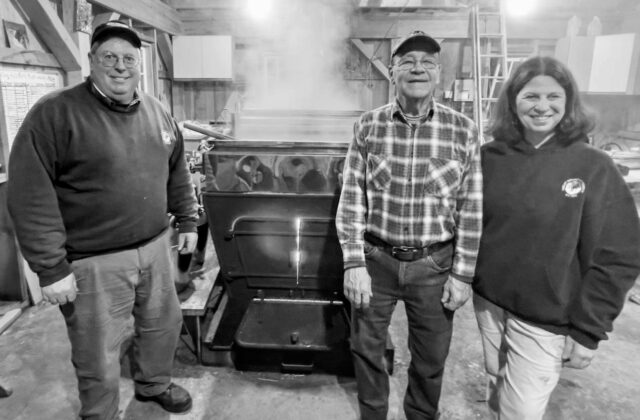Wayne Jenkins Recalls Almost 60 Years of Syrup Making
A Labor of Love
Text By Jude Mead
Photo by Scott Whalen
The maple syrup season is once again wrapping up for the year. For most producers, the season started off strong, one of the earliest ever noted in the area according to ACSERnet, an international network of scientists studying the maple tree’s ecology. Maple syrup production has always been dependent on weather conditions, with the ideal situation being freezing at night and warm during the day. This has been constant since the Native Americans and early settlers first developed the process centuries ago. While the temperature conditions for a good sap flow have remained the same, other things have changed, and Wayne Jenkins has seen many of them.
Jenkins became interested in maple syrup production in 1965 when he started working at Great Mountain Forest. It was there he met Ted Childs, owner of GMF and an avid syrup producer with 25 years of experience behind him. Childs taught Jenkins how to run the operation. Soon after, Jenkins, along with his crew Darrell Russ, Joel Bronson and Russell Russ, took over the labor-intensive work. The men used buckets and brawn to get the job done.
They did not have vehicles to maneuver through the thick woods, but instead had to tromp through on foot, carrying most of their supplies. “We usually set the taps out around Presidents’ Day in February. We had 1,700 buckets to hang on the trees and could carry only 25 of them at a time. As we walked through the woods, we would drop two, three, or four at each maple tree depending on the number of taps. We then returned to the sugarhouse to grab more,” said Jenkins. Jenkins added that if snow was on the ground, they would have to pack a trail first in snowshoes before slipping into their work boots. To tap the trees, Jenkins used a hand brace and bit drill or a battery-powered one to make the holes. “We used a 7/16-inch bit. That’s large, unlike the small bits used today,” he said.
Once the sap started running and the buckets filled, it was time for collecting. “We would empty the buckets into carrying pails that held four gallons each. We would carry one in each hand. That’s over 60 pounds we hauled over stonewalls and tough terrain to the dirt road. There we pumped the sap into a 1,200-gallon milk tank that sat on the back of a flatbed truck,” Jenkins said. He also explained that in some areas they dumped the sap into a pipeline and let gravity pull it downhill to a central collection point.
The sap was then boiled in the two large evaporators at the sugarhouse. “We used wood to boil the sap down and would boil about 150 gallons of sap an hour,” Jenkins said. “One evaporator used four-foot wood, and the other one used two-foot wood. On a good day we could make 20 to 25 gallons of syrup depending on the sweetness of the sap. We would start in the morning and boil late into the night. We were able to cut back on boiling time once we got a reverse osmosis machine.” Jenkins added that GMF was the first in the area to have one, and syrup producers throughout New England would stop by to see it. The RO machine removes much of the water from the sap, thus cutting down on boiling time. “The faster you can boil, the better grade syrup you have,” said Jenkins.
Jenkins explained that it takes about 43 gallons of sap to produce about one gallon of syrup if the sap has a 2 percent sugar content. He would use a hydrometer to test the density, and if ready, he would open the spigot to pour it off. From there it was brought to another room and filtered to remove any naturally occurring minerals left behind. “Before we got our electric filter press, we used a paper and felt filtering system. This was a slow process. We hung the filters over a metal tank and waited until the syrup filtered through. We reheated the syrup to 180 degrees and bottled it.”
According to Jenkins, even the grading system has been updated, though the syrup is still graded by color. “It used to be graded Fancy, Grade A and Grade B, but now it’s all Grade A. In the early part of the season, it is called Grade A Delicate or Grade A Amber Rich. As the season progresses, the syrup darkens to either Grade A Dark Robust or Grade A Extra Dark. All grades of syrup have the same sugar content.”
Jenkins retired from GMF but still produces maple syrup with his daughter Holly. She recalls spending many hours with her dad at the sugarhouse. “I grew up around it. When I married Jeff Torrant we both knew we wanted to build our own sugar house. My dad and our friend Tim Munch helped us get started. It’s been nine years and we are still enjoying it.”
Though the Torrants favor the more modern approach of using tubing and technology, the essence of the process is virtually the same as the family tradition continues. Jenkins and his family agree that producing maple syrup “is really a labor of love.”

